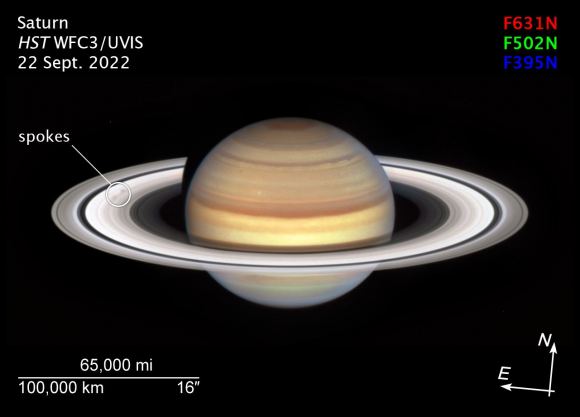The Hubble Space Telescope recently captured the appearance of several asymmetrical ‘spokes’ rising above the rings of Saturn, marking a coming change in season for the ringed gas giant. The spokes are made of charged ice particles bulging up and away from the rest of the rings. Researchers aren’t sure exactly what causes the spokes, but they suspect it has something to do with the planet’s powerful magnetic fields.
This isn’t the first time the spokes have been observed. They were discovered in the 1980s by the Voyager missions, and more recently, the Cassini spacecraft captured the phenomena up close. Since the end of the Cassini mission in 2017, observations of the Saturnian system have largely been carried out from afar using Hubble and other Earth-based telescopes. Hubble’s recent observations, captured last September, mark the beginning of a new spoke cycle.
By now, we know that the spokes are a seasonal phenomenon. Like Earth, Saturn cycles through a four-season year based on its tilt, though it takes about thirty Earth years to complete one cycle due to Saturn’s more distant orbit. The spokes tend to occur around the equinox, when the rings are edge-on to the Sun, and fade away as the summer or winter solstices draw near.

The leading theory explaining the spokes (which sometimes look more like blobs than the radial lines we traditionally associate with spokes) has to do with Saturn’s magnetic field. The solar wind is constantly interacting with the magnetic field, producing auroras on Saturn just like those we see on Earth’s poles. A similar effect may explain the spokes.
When the rings are edge-on to the Sun, the smallest of the icy particles that make up Saturn’s rings can pick up an electric charge, which temporarily ejects them up and away from the rest of the ring material.

“Despite years of excellent observations by the Cassini mission, the precise beginning and duration of the spoke season is still unpredictable, rather like predicting the first storm during hurricane season,” said NASA planetary scientist Amy Simon.
It’s unclear if a similar phenomenon occurs in the rings around Uranus or Neptune, which are fainter and further away.
To better understand the spokes and other seasonal variations in Saturn’s atmosphere, researchers need to continue to collect data over decades, allowing the system’s long-term changes can be documented. In order to continue building such a dataset in the absence of Cassini, NASA’s Outer Planet Atmospheres Legacy (OPAL) program is regularly monitoring the ringed planet using Hubble, and will continue to do so as long as the venerable space telescope is capable.



